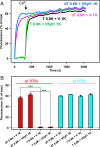Synaptotagmin-1-, Munc18-1-, and Munc13-1-dependent liposome fusion with a few neuronal SNAREs
- PMID: 33468652
- PMCID: PMC7848701
- DOI: 10.1073/pnas.2019314118
Synaptotagmin-1-, Munc18-1-, and Munc13-1-dependent liposome fusion with a few neuronal SNAREs
Abstract
Neurotransmitter release is governed by eight central proteins among other factors: the neuronal SNAREs syntaxin-1, synaptobrevin, and SNAP-25, which form a tight SNARE complex that brings the synaptic vesicle and plasma membranes together; NSF and SNAPs, which disassemble SNARE complexes; Munc18-1 and Munc13-1, which organize SNARE complex assembly; and the Ca2+ sensor synaptotagmin-1. Reconstitution experiments revealed that Munc18-1, Munc13-1, NSF, and α-SNAP can mediate Ca2+-dependent liposome fusion between synaptobrevin liposomes and syntaxin-1-SNAP-25 liposomes, but high fusion efficiency due to uncontrolled SNARE complex assembly did not allow investigation of the role of synaptotagmin-1 on fusion. Here, we show that decreasing the synaptobrevin-to-lipid ratio in the corresponding liposomes to very low levels leads to inefficient fusion and that synaptotagmin-1 strongly stimulates fusion under these conditions. Such stimulation depends on Ca2+ binding to the two C2 domains of synaptotagmin-1. We also show that anchoring SNAP-25 on the syntaxin-1 liposomes dramatically enhances fusion. Moreover, we uncover a synergy between synaptotagmin-1 and membrane anchoring of SNAP-25, which allows efficient Ca2+-dependent fusion between liposomes bearing very low synaptobrevin densities and liposomes containing very low syntaxin-1 densities. Thus, liposome fusion in our assays is achieved with a few SNARE complexes in a manner that requires Munc18-1 and Munc13-1 and that depends on Ca2+ binding to synaptotagmin-1, all of which are fundamental features of neurotransmitter release in neurons.
Keywords: membrane fusion; neurotransmitter release; reconstitution; synaptic vesicle fusion; synaptotagmin-1.
Conflict of interest statement
The authors declare no competing interest.
Figures




Similar articles
-
Reconstitution of the vital functions of Munc18 and Munc13 in neurotransmitter release.Science. 2013 Jan 25;339(6118):421-5. doi: 10.1126/science.1230473. Epub 2012 Dec 20. Science. 2013. PMID: 23258414 Free PMC article.
-
Munc18a does not alter fusion rates mediated by neuronal SNAREs, synaptotagmin, and complexin.J Biol Chem. 2015 Apr 17;290(16):10518-34. doi: 10.1074/jbc.M114.630772. Epub 2015 Feb 25. J Biol Chem. 2015. PMID: 25716318 Free PMC article.
-
Synaptotagmin-1 is an antagonist for Munc18-1 in SNARE zippering.J Biol Chem. 2015 Apr 17;290(16):10535-43. doi: 10.1074/jbc.M114.631341. Epub 2015 Feb 25. J Biol Chem. 2015. PMID: 25716321 Free PMC article.
-
Neuronal SNARE complex assembly guided by Munc18-1 and Munc13-1.FEBS Open Bio. 2022 Nov;12(11):1939-1957. doi: 10.1002/2211-5463.13394. Epub 2022 Mar 22. FEBS Open Bio. 2022. PMID: 35278279 Free PMC article. Review.
-
Molecular Mechanisms Underlying Neurotransmitter Release.Annu Rev Biophys. 2022 May 9;51:377-408. doi: 10.1146/annurev-biophys-111821-104732. Epub 2022 Feb 15. Annu Rev Biophys. 2022. PMID: 35167762 Free PMC article. Review.
Cited by
-
Roles for diacylglycerol in synaptic vesicle priming and release revealed by complete reconstitution of core protein machinery.Proc Natl Acad Sci U S A. 2023 Aug 22;120(34):e2309516120. doi: 10.1073/pnas.2309516120. Epub 2023 Aug 17. Proc Natl Acad Sci U S A. 2023. PMID: 37590407 Free PMC article.
-
Altered synaptic homeostasis: a key factor in the pathophysiology of depression.Cell Biosci. 2025 Feb 25;15(1):29. doi: 10.1186/s13578-025-01369-y. Cell Biosci. 2025. PMID: 40001206 Free PMC article. Review.
-
The function of VAMP2 in mediating membrane fusion: An overview.Front Mol Neurosci. 2022 Dec 23;15:948160. doi: 10.3389/fnmol.2022.948160. eCollection 2022. Front Mol Neurosci. 2022. PMID: 36618823 Free PMC article. Review.
-
Novel Roles for Diacylglycerol in Synaptic Vesicle Priming and Release Revealed by Complete Reconstitution of Core Protein Machinery.bioRxiv [Preprint]. 2023 Jun 7:2023.06.05.543781. doi: 10.1101/2023.06.05.543781. bioRxiv. 2023. Update in: Proc Natl Acad Sci U S A. 2023 Aug 22;120(34):e2309516120. doi: 10.1073/pnas.2309516120. PMID: 37333317 Free PMC article. Updated. Preprint.
-
Synaptotagmin-1 undergoes phase separation to regulate its calcium-sensitive oligomerization.J Cell Biol. 2024 Oct 7;223(10):e202311191. doi: 10.1083/jcb.202311191. Epub 2024 Jul 9. J Cell Biol. 2024. PMID: 38980206 Free PMC article.
References
-
- Söllner T., Bennett M. K., Whiteheart S. W., Scheller R. H., Rothman J. E., A protein assembly-disassembly pathway in vitro that may correspond to sequential steps of synaptic vesicle docking, activation, and fusion. Cell 75, 409–418 (1993). - PubMed
-
- Hanson P. I., Roth R., Morisaki H., Jahn R., Heuser J. E., Structure and conformational changes in NSF and its membrane receptor complexes visualized by quick-freeze/deep-etch electron microscopy. Cell 90, 523–535 (1997). - PubMed
Publication types
MeSH terms
Substances
Grants and funding
LinkOut - more resources
Full Text Sources
Other Literature Sources
Molecular Biology Databases
Miscellaneous

